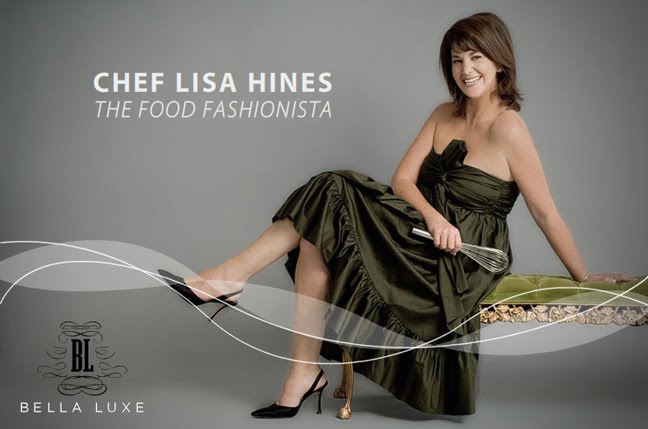We're just dining in the dark
by Leslie Harlib, Marin Independent Journal
September 20, 2007
At first it looked like a torture scene: a huge, echoing room with blacked-out windows, 100 blindfolded people sitting at black-clothed tables and black-clad people bristling with night-vision goggles looming over them.
But it was San Francisco's inaugural Dark Dining event, and it was one of the most entertaining food fests I've experienced in years.
The unlit culinary adventure, featuring a three-course meal by San Rafael-based chef and caterer Lisa Ruggieri Hines, at San Francisco's Fort Mason, was the bright idea of A.K. Crump.
Crump's a Web TV maestro (he founded Taste TV in 2004), and publisher and producer of the first San Francisco International Chocolate Festival in July. The San Francisco resident decided to launch a Bay Area version of dark dining, a phenomenon that began in Zurich in 1999, after reading about a growing trend toward dark dining taking place in various cities in Europe as well as in New York, Los Angeles and San Diego.
"I was sure people in the Bay Area would find it a fascinating concept," he said. A fan of Ruggieri Hines' cooking, he asked her to design the menu.
Dark dining is about entirely blocking out a diner's vision so other senses - touch, smell, taste, even hearing - more acute. This lets you experience the act of eating in new ways.
To do this, restaurants either black out windows, turn out lights and offer blindfolds (or napkins, as it was handled for the maiden run at Fort Mason) or set up separate windowless rooms for the dinners.
In Zurich's Blinde Kuh (Blind Cow), the original concept was to give work to blind waiters and allow diners to sample a crumb of what life - and dining - is like for the blind.
Most dark dining events hire sighted servers, who wear night vision goggles to maneuver around the room.
"I like this; I'll be lucky if it doesn't give me a migraine," said server Mathew Blair, as he donned the head-hugging goggles to go out on the floor.
"It sounded fascinating. I've never done anything like this," said Mill Valley resident Cindy Storman, who attended with pals, including Francess Mudge-Lisk, also from Mill Valley. "I'm curious and excited."
Ryan Bagnule of Charlotte, N.C., was in San Francisco on business and heard about the event. "It's an exercise in trust," he said over a pre-dinner amuse bouche of ahi tuna in phyllo pastry cup. "I think we'll be able to relax fear so we can be in complete darkness eating with strangers we don't know. Darkness is comforting."
In the dimness, it was disappointing to realize we could still see each other, albeit in silhouette. Crump suggested that those who wanted to experience total darkness tie their black napkins around their eyes. What a difference. With the tightening of the knot we were plunged into the Stygian dark that spelunkers understand. It felt like being on a journey.
Unlike at many events where people at a large tables talk only to the person they came with or make small talk with the folks to their left or right, groups immediately developed rapport.
My gang of seven quickly slid into a game of truth or dare that we continued for more than two hours. We got so involved in challenging each other we could have happily lived without the live background music, which was intrusive.
As for the food, Ruggieri Hines' substantial meal included two heavily dressed salads, both of which featured nuts and cheese; entrees of either roast chicken breast with pomegranate sauce, truffled mashed potatoes and green beans or wild salmon with corn and bay shrimp risotto and spinach; and a choice of one of three desserts.
Silverstone wines from Paso Robles were poured. We gingerly fingered along the tablecloth until we found the glasses and sipped without difficulty. I didn't hear any groans about spillage.
I found that I didn't enjoy using silverware, which in my sightless state made the food feel too remote, so I shifted into messy mode as I ate every dish with my right hand.
Did I experience the flavors more acutely? Certainly I did with the red wines. The difference between a pinot noir and zinfandel had never seemed more dramatic.
Ruggieri Hines said the improvised kitchen was challenged with its own moments of darkness, although though she and her staff cooked in light.
"The fuses kept blowing," she laughed. "At one point I reached for a bottle of olive oil to put it in a gazpacho; it turned out to be dishwashing liquid. We did not serve the gazpacho."
skip to main |
skip to sidebar
Followers
Get more at bellaluxe
The Food Fashionista Manifesto
Say Yes to West Coast Luxe!
Book The Food Fashionista for your next event!
Write to The Food Fashionista
Blog Archive
The Food Fashionista Has Been Featured On ABC 7 San Francisco
Also, The Food Fashionista has appeared on, in or at
TasteTV, Marin Magazine, SF Station, Williams-Sonoma
Bella Luxe Chef Lisa Hines, The Food Fashionista
The Food Fashionista's Favorite Sites
Advertising
Chef Lisa Hines owns Bella Luxe, the brand that stands for fabulous, never fussy, living. Within this brand, she leads a family of inspired foodies and respectfully irreverent event planners at Bella Cucina Catering, serving San Francisco and Marin. Phone: 415.454.3858
All rights reserved. Copyright Bella Luxe 2008-2009.







